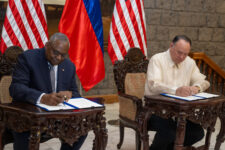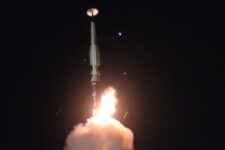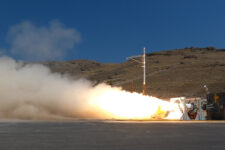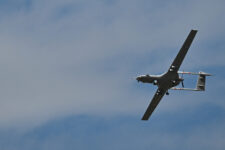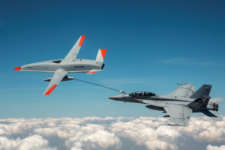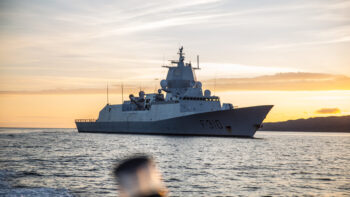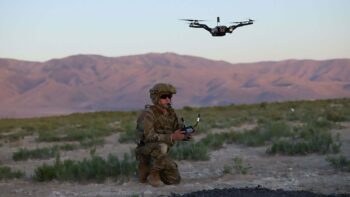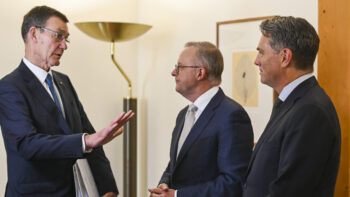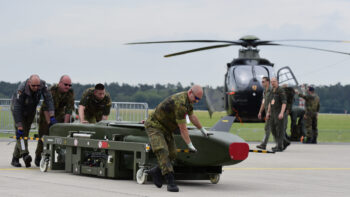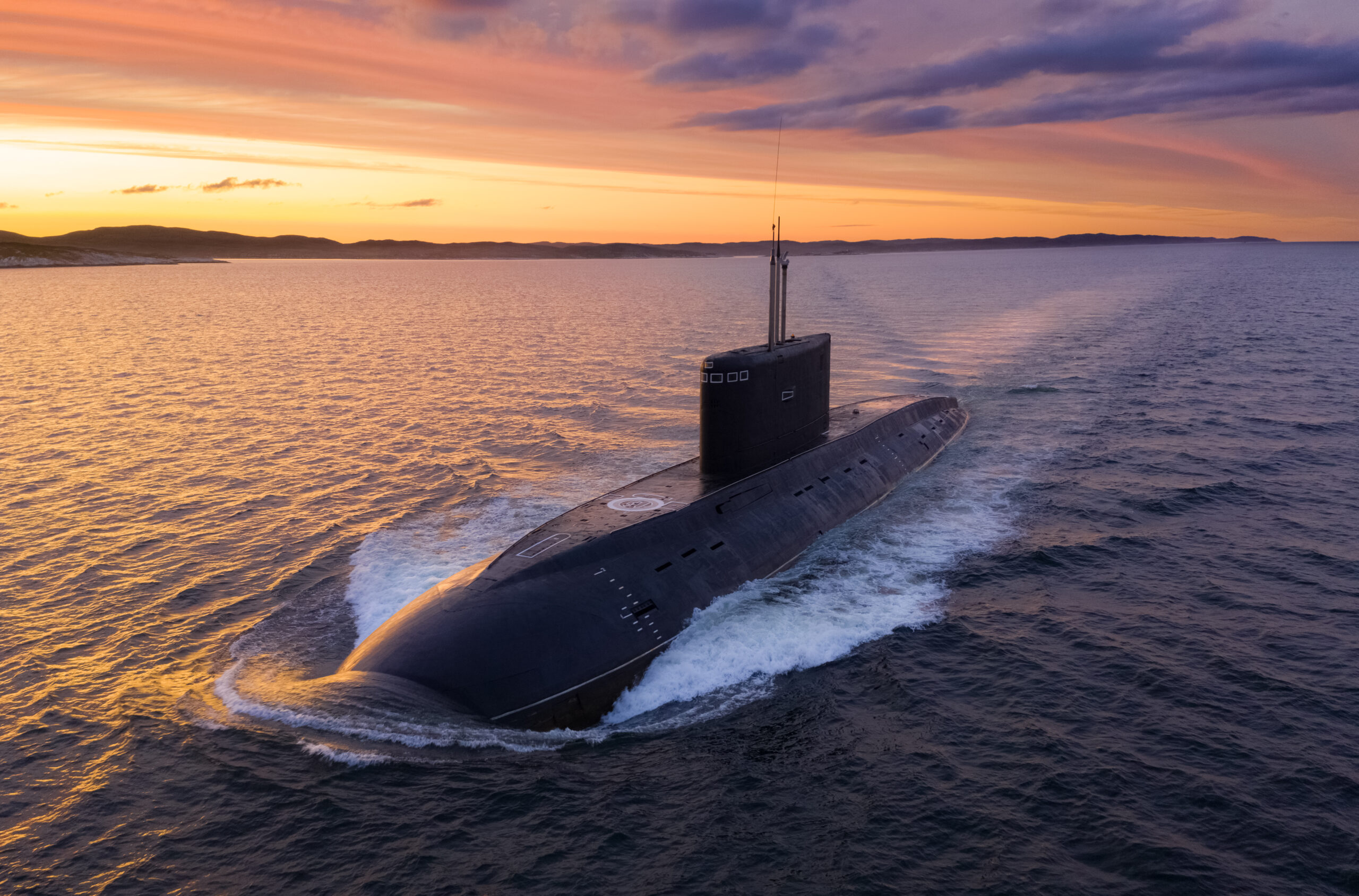
Honeywell is well positioned to support AUKUS as it has defense and space operations in Australia, UK, and U.S., and actually supports all three countries’ existing submarine programs. Image provided by Honeywell Australia.
Australia is embarking on its largest and most important industrial mobilizations in two main areas. The first is the AUKUS nuclear-powered submarine program among Australia, UK, and U.S. The second is Guided Weapons and Explosive Ordnance (GWEO) Enterprise.
In this Q&A with Lee Davis, defense and space leader for Honeywell Australia, which also has regional responsibility for New Zealand and Oceania, we discuss: Honeywell’s six-plus decades in Australia; it’s programs supporting F-35, F-18, and the Abrams battle tank; its present-day work on submarines and missiles; and how it’s supporting the Australian Government Department of Defence in helping to strengthen and grow the country’s industrial sectors and supply chains.
Breaking Defense: Tell us about Honeywell’s presence in Australia.

Lee Davis is the defense and space leader for Honeywell Australia.
Lee Davis: Honeywell started operations in Australia in 1962 and now operates in every state and territory. We employ over 1,700 people in-country across 25 locations, which is quite diverse for an international footprint. We have a lot of capability on the ground and a long history of partnering with local industry.
In defense and space, the products we support are varied and include technologies such as navigation, guidance, actuation systems, power thermal technologies, wheels and brakes, avionics, oxygen breathing systems, and I could go on and on.
As a large industrial with over 160,000 products, we have a lot of content in air, land, and sea assets in Australia supporting the Royal Australian Air Force and Navy and Australian Army. For the 100th anniversary of the Air Force, they released an image of all their platforms together on the tarmac and every one of them included Honeywell content – everything from F-35 through to King Air general aviation aircraft that they use for navigation training.
We need to start a campaign for ‘Honeywell Inside’ like Intel did with its ‘Intel Inside’ logo.
Before we discuss AUKUS and guided missiles, describe some of the work you’re doing today to support the Australian Government Department of Defence.
We support the Defence Force through a range of avenues. We have engagements where we support them directly, contractually and physically working directly for them, supporting our products here.
In general, though, we usually work through the prime system integrators and platform providers, think a Lockheed Martin with JSF or a Boeing with Super Hornet, where we’re providing capability into those partners in-country.
The third way is through local small-to-medium enterprises. TAE Aerospace and Rosebank Engineering are two companies that we partner with where we look to transfer technology into those businesses locally so they can do full-repair MRO work on our products in support of the Defence Force. We always look to find local partners where we can increase capability not just inside Honeywell Australia but inside our partner network.
Those companies are engaged on critical sustainment activities for the F-35 and Super Hornet programs, as well as the Abrams tank program. Not a lot of people probably think ‘Honeywell’ when they think of the main battle tank, but the engine in the Abrams is a Honeywell engine and we have been working with TAE for a number of years to enhance their capability to be able to completely service those platforms for the Australian Army.
What are your thoughts on the role Honeywell Australia can play on AUKUS?
The AUKUS program is interesting because it’s the largest industrial endeavor ever in Australia in terms of complexity, dollars, and scale. There’s been marquee industrial programs in Australia like the Snowy Hydro-electric system after the second World War and the enhanced Snowy 2.0 program which have been massive infrastructure investments. The AUKUS submarine program dwarfs both of those programs, and you’re talking 30,000 people required in the submarine industry in Australia to support that.
(Editor’s note: the Snowy Hydro-electric program started construction after World War II in New South Wales and consists of 9 hydro-electric power stations and 16 large dams connected by 145 kilometres of tunnels and 80 kilometres of aqueducts.)
Like with the Abrams, when people think submarines they don’t necessarily think Honeywell straight away. Honeywell, however, is uniquely positioned because we have defense and space operations in all three countries and actually support all three countries’ existing submarine programs. We already have content in submarines from navigation and actuation systems to power and thermal management. The things we do in aircraft and aerospace we do in submarines.
We also do nuclear stewardship. We secure all of the nuclear defense sites in the U.S. with our infrastructure security architecture. We’ve been supporting the nuclear mission in the U.S. for over 75 years, including a focus on industrial security and supply chain excellence. We also support the UK nuclear mission. In addition to the nuclear pedigree Honeywell also has direct content on the Virginia class submarine, and has completed early design work on the SSN AUKUS submarine that BAE Systems is currently designing.
Given that combined heritage of nuclear stewardship and submarine component production, we are looking to support the Australian customer in the following areas: infrastructure security for existing and new submarine bases and sites that will control technology related to the submarines and nuclear propulsion system; industrial base development by working with the Australian industrial base to develop secure, qualified suppliers and managing them to provide critical components into those programs; and nuclear waste support, where we’ve been involved in nuclear waste management and remediation programs in the U.S. for a long time.
If AUKUS is the top industrial venture, then guided missiles under GWEO is second. What are your thoughts for how Honeywell Australia can support that effort?
In the guided weapons space, we see a common theme between the content that we have in an airborne platform, a submarine, and a missile. That includes control and actuation systems for guided weapons, air data computers, antennas, precision sensors, flight-control systems, guidance and navigation systems, mission processing, precision valve control, protective technologies, radar altimeters, RF units and inertial measurement units – all the key piece parts that go into a guided weapon.
Looking at Australia’s inventory and what’s being procured, there’s Honeywell content in over 80 percent of those platforms, including both Lockheed Martin and Raytheon missiles. Both companies have been announced in Australia as the strategic partners for the guided weapons enterprise. We want to see where we can transfer those technologies that I just talked about to support and sustain them locally.
Recent events around the world have highlighted the challenges with supply chains. One thing that Defence is looking to do in Australia through this program is secure up its supply chain around guided weapon supply. That’s both stock in the cupboard in terms of war stock, and also local capability to repair, produce and modify those components.
One of your most important programs is providing components for Lockheed Martin’s Guided Multiple Launch Rocket System (GMLRS) rocket used in the M142 High Mobility Artillery Rocket System (HIMARS). Tell us about that.
GMLRS is one of the priority areas for the Australian government. They’ve announced an initial contract with Lockheed Martin to start assembly of those rounds in Australia next year. We have content on GMLRS and our number-one priority in this area is to support that endeavor.
As in other programs, the focus for the Defence Force is getting sovereign capability in-country. It’s not just about procuring the weapon, but about securing the supply chain and the ability to support that weapon domestically.
What we’re doing now, as I touched on earlier, is looking at the critical infrastructure that can support that. If you look at guided weapons, it’s a giveaway in the title. Guided navigation is certainly the critical component in a guided weapon. Honeywell has a long history in guidance systems and it’s a strong focus area for us.
We’ve been looking to establish capability in-country to be able to test and calibrate guidance systems. Once you can do that, you can then step into areas like MRO where you’ve got the capability to locally diagnose and repair these types of components. Once you can test and diagnose, you can then step into things like assembly and start sourcing components and doing production in-country, as well.
That’s the roadmap we’re looking at from a guided weapons perspective: establish the capability to do test and calibration, move into being able to support the Defence Force through MRO and assembly tasks, and then sourcing components in our global supply chain from Australia.
The Apache attack helicopter is coming to Australia. How will Honeywell leverage its experience supporting Chinook for the Australian Defence Force/Australian Army to Apache?
We have a number of Air Force and Army airborne platforms in Australia: Chinook, Wedgetail, P-8s, F-18s, F-35s. Across fixed wing and rotary aircraft there are a number of common components like auxiliary power units, navigation systems, air and thermal management.
We already support the Australian Defence Force across a range of those product sets in-country where, as I said before, we’ve enabled local partners like TAE and Rosebank to be able to do APU repairs and mechanical repairs on components, and also moving into electronic components.
As Apache comes into country, there are common elements in Apache with our other platforms that we already support. We would look to extend that through ourselves and our partners to provide the Defence Force with local sustainment options.
In Australia, typically they would take one of two paths in sustaining their platforms. They would look to establish Foreign Military Sales links back to the U.S. to do government transfers, and alternatively repairs of those components where it makes sense and the capability exists in-country. Then they look to authorize their local partners for direct commercial work. That’s what we will be looking to support locally.
Obviously Boeing is the platform OEM for Apache, and they are responsible for providing that frontline service in Australia for the platform. We will work with them like we do on Super Hornet and Wedgetail programs amongst others to provide that local support in areas like navigation systems and APUs.
What are Australia’s needs in space and UAS, and how can Honeywell help?
Honeywell has a deep history in both areas. We’ve supported the U.S., in particular NASA, on every crewed space mission since the early Apollo program. We’ve got a deep history and heritage in space from satellite components through to life support systems on the International Space Station. We certainly would be looking to leverage that capability locally.
Like our work in airborne assets and missiles, we manufacture similar components in space and unmanned systems (UAS). Through those capabilities, we’re looking to support Australia through marquee programs like JP 9102, which is the country’s first sovereign military satellite program. We’d be looking to support Lockheed Martin, who was selected as the prime contractor for that program, with critical satellite and ground-station componentry.
In UAS, the marquee program in Australia is the Ghost Bat development program by Boeing. Again, we’re supporting Boeing with a range of components for their program.
These are the types of things that we’re looking to enhance from a space and UAS perspective, and I only see these growing in the coming years.
Final thoughts?
Honeywell established its operations in Australia in 1962. We’re in every state and territory, 25 locations, 1,700 people, long history partnering with local companies like TAE and Rosebank, capability across air, land, and sea platforms, and focused on growth on AUKUS and GWEO.
If you look inside any defence asset in-country, it’s highly likely to have Honeywell inside. So whilst you might not think ‘Honeywell’ in defence and space we’re absolutely there.








